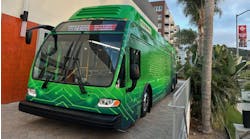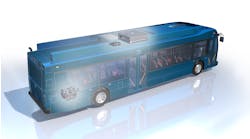When it comes to the challenge of operating all-electric transit buses, keeping the bus powered to run the route is typically met with a plug-in charge, undercarriage connection or overhead catenary. The bus often charges at a strategic bus stop, such as end of route, where they need to accommodate the additional time to connect to the power source and charge.
Utah Transit Authority has been working with Utah State University and WAVE Technologies Inc., a spin-out company from USU, in operating an all-electric bus that runs on wireless power transfer (WPT) technology. The route is a 1.5-mile, 10-minute route that cuts through campus, connecting to a UTA Trax station. UTA General Manager Mike Allegra said the university looks at the route as a “moving walkway” to move people across campus quickly — and quietly.
The university purchased the Complete Coach Works ZEPS bus, a retrofitted Gillig. The weight of the charging plate adds about 100 additional pounds to the vehicle.
The WPT technology happens magnetically — no wires, no connectors. There is a charging plate attached to the undercarriage of the bus and one in the ground. When the bus pulls over the pad, the charging plate that is underground converts direct current voltage to high-frequency alternating current. As the AC voltage passes through a transmitting coil, it is turned into a high-frequency magnetic field. Receivers in the plate under the bus convert the magnetic field to a DC voltage output which charges the battery.
The charging plates are flush-mount in the ground and there is a 7.5-inch gap between the pad and charger. WAVE Chief Development Officer & Founder Wesley Smith explained it has 90 percent efficiency, comparable to conductive which is typically 92 percent. There isn’t any infrastructure for alignment; only visual cues are needed.
The embedded charging pads are about 3-feet square and work through ice, mud or snow on the road. The system meets the International Standard for Electromagnetic exposure to humans so people can walk across the pad with no safety concerns. It also means the charging doesn’t interfere with such things as pacemakers.
The bus will charge for five minutes at each end of the route. Powering frequently during operation, it enables the use of a smaller battery – saving weight and money. Smith said no moving parts needed to connect to charge also means less in maintenance costs.
The charging pad can accommodate variable vehicular use, whether streetcars, SOVs or delivery trucks.
The project was funded through a Federal Transit Administration TIGGER grant for $2.7 million to develop this WPT technology. The initial prototype 25kW system began running in late 2012.
UTA General Manager Mike Allegra said their agenda is to remake the image of the bus. “People want to ride the system of the future.”





